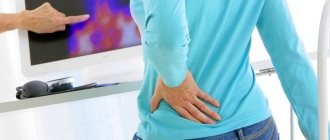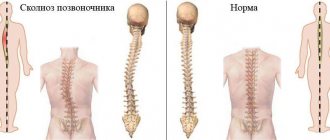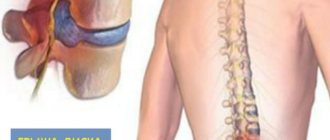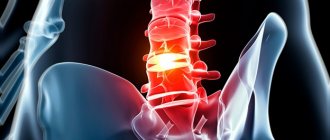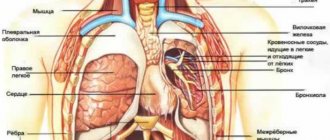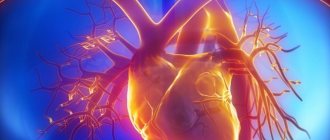Thoracic osteochondrosis
is a degenerative-dystrophic disease in the middle parts of the spine. It occurs much less frequently than lumbar and even cervical osteochondrosis and accounts for about 10% of all cases of the disease. Symptoms of thoracic osteochondrosis are associated with several features of the spine in the thoracic region: rigid fixation of the vertebrae due to the ribs and skeletal muscles and less mobility, a semicircular bend of the ridge in this region and the corresponding distribution of the load.
Thoracic osteochondrosis is a disease of the middle parts of the spine.
Symptoms of thoracic osteochondrosis begin with a violation of tissue trophism and dehydration of the intervertebral discs. Lack of nutrients and fluid leads to the fact that cartilage loses its elasticity, begins to crack and “sag”
.
This state of affairs is fraught with compression of the nerve roots, deterioration of sensitivity and functioning of internal organs, as well as severe pain. Often, the destruction of the vertebrae in the thoracic region is accompanied by the appearance of osteophytes
- bone outgrowths that injure the paravertebral tissues and lead to chronic inflammation.
Contrary to popular belief, thoracic osteochondrosis is not a natural age-related process and requires special treatment. The onset of the disease can occur at the age of 25 years
;
approximately 70% of the total number of patients are women aged 35 to 55 years. Since the disease begins long before retirement age, it can lead to limitations and even loss of ability to work
.
Unlike other types of osteochondrosis, thoracic osteochondrosis may not manifest itself for a long time - or disguise itself as other pathologies, which is why it is called a chameleon disease. It is also the most difficult to treat. Therefore, it is very important to promptly monitor the symptoms of thoracic osteochondrosis.
- and today we will tell you which ones.
What is thoracic osteochondrosis?
Osteochondrosis of the thoracic spine is a regenerative (destructive) process localized in the interval from 8 to 19 vertebrae, which forms the human thoracic spine.
Unlike other types of the disease, symptoms of thoracic osteochondrosis can occur in both young and elderly people.
A feature of the disease is the difficulty of its early diagnosis, which is associated with low mobility of the spine and the difficulty of identifying the main symptoms. For this reason, it is important to promptly consult a specialist when detecting the first signs of thoracic osteochondrosis in order to prevent irreversible processes.
Dorsagia and Dorsago
Against the background of thoracic osteochondrosis, one can often notice the formation of vertebral syndromes: dorsalgia and dorsago.
Dorsago is the instant formation of acute pain in the sternum. As a rule, this condition is observed in those who remain in one position for a long time, for example, sitting. The syndrome can develop during the process of standing up after a long stay at the table in an unchanged position. Dorsago is characterized by the appearance of unbearable pain and limited movement in the spine.
Unlike dorsago, dorsalgia develops gradually. With this syndrome, slight pain and discomfort appears in the affected area of the ridge. An increase in pain is observed when taking a deep breath and bending the body.
The muscles become tense and movements in the spine become limited. Typically, the pain increases in the evening and goes away in the morning after a 10-minute walk.
The presence of other pain syndromes against the background of osteochondrosis in the thoracic region.
With this pathology, other pain syndromes may develop, which complicate the accurate diagnosis of the disease. When the disease spreads to the area of the upper thoracic segment of the sternum, pain appears in the esophagus, larynx, and a “lump in the throat” is felt. If the lesion is located in the mid-thoracic segment, discomfort occurs in the right hypochondrium.
When the pathology spreads to the area of the lower thoracic segment, pain in the peritoneum develops, similar to signs of a disease in the intestines.
It is worth noting that there is no relationship between the pain syndrome due to thoracic osteochondrosis and the patient’s nutritional quality. Moreover, pain can appear regardless of the time of year. Although the pain associated with this disease can increase in the evening and during physical overload. By morning, the discomfort usually disappears or subsides.
Causes
The main cause of osteochondrosis of the thoracic spine is the occurrence of dystrophic processes (disorders of cellular metabolism) that transform tissues and provoke complications of metabolic actions, which is caused by an insufficiently balanced diet and improper load on the intervertebral discs.
In addition, the list of factors that increase the risk of developing thoracic osteochondrosis includes:
- the presence of intervertebral hernias;
- impaired blood supply to the spinal cord;
- disturbance of mineral balance in the body;
- regularly increased loads on the spine;
- predominantly sedentary lifestyle;
- consequences of previous injuries;
- engaging in active sports.
How to prevent the development of pathology?
Our doctors recommend the following prevention methods:
- during the day, lie down for 40-50 minutes - this will relieve the load on the spine;
- if you work a lot at the computer, change your position, get up from your chair every 2 hours, bend a couple of times in different directions, stretch, straighten your shoulders;
- engage in water sports: swimming, diving, water aerobics;
- do not get too cold, keep your back warm;
- Do the following exercise regularly: lying on your stomach, place your hands on the floor and bend back. Stay in this position for 5-10 seconds. Repeat the exercise 8-10 times.
The main symptoms of osteochondrosis of the thoracic region
Chest pain with osteochondrosis is the main symptom of the clinical picture. However, considering the general symptoms of osteochondrosis of the thoracic region, we can also highlight:
- difficulty breathing, chest tightness;
- difficulty in bending;
- periodic occurrence of a feeling of freezing of the extremities due to circulatory failure;
- brittle nails and hair;
- nausea, digestive disorders;
- pain that is easily confused with that that accompanies cardiovascular diseases;
- soreness of the mammary glands in women;
- discomfort and difficulty swallowing, cough.
The manifestation of several symptoms of thoracic osteochondrosis requires immediate consultation and a full examination by a specialist in order to make an accurate diagnosis and determine a treatment plan for thoracic osteochondrosis.
Stages of disc degeneration
The progression of disc degeneration can be classified into the following stages:
Dysfunction
- Possible tears in the area of the fibrous ring of the disc, with irritation of the facet joints at the corresponding level of the spine.
- Loss of joint mobility, local back pain, muscle spasm and restrictions in trunk mobility, especially extension.
Instability
- Loss of fluid from the disc with dehydration and decreased disc height. Weakness of the facet joints and capsules may develop, leading to instability.
- The patient will experience shooting pain, straightening of the spine and a sharp decrease in the range of motion in the torso.
Restabilization
- The human body responds to instability by forming additional bone formations in the form of osteophytes, which, to a certain extent, stabilize the spine. But excess bone formation can lead to spinal stenosis.
- Back pain usually decreases but remains less intense. Some people may develop stenosis-like symptoms.
Stages of disease development
Experts distinguish three main stages of development of thoracic osteochondrosis:
Stage 1 – the beginning of the development of the disease. Characterized by the absence of clinical manifestations.
Signs of stage 1 thoracic osteochondrosis:
- barely perceptible, slight painful lumbago, accompanied by a nagging pain in the chest. Unpleasant sensations intensify after strenuous work or heavy lifting;
- muscle spasms, constant tone of the muscle frame for no apparent reason;
- discomfort in the heart area.
Seeing a doctor at the initial stage of the disease guarantees a complete cure of the disease.
Stage 2 – the progression of the disease leads to the formation of microcracks in the intervertebral discs, which causes limited mobility and the appearance of severe pain.
Clinical manifestations include:
- visually noticeable deformation of the spinal column;
- decrease in pressure;
- accompaniment of an attempt to place the hand behind the head with palpable pain in the sternum;
- chronic feeling of fatigue;
- discomfort in the area of the heart and spinal column of the thoracic region.
If the disease is detected at this stage, the process of restoring health may require a fairly long period of time.
Stage 3 is an advanced process that has a negative impact on the entire body as a whole.
Dangerous manifestations such as:
- limited mobility of the spine;
- sharp pain;
- the appearance of intervertebral hernias;
- pinching of blood vessels and nerve roots;
- diseases of the biliary tract.
Refusal to treat thoracic osteochondrosis at this stage can lead to disability.
Exercise therapy
Therapeutic physical education plays one of the leading roles in the treatment of thoracic osteochondrosis, since it allows:
- strengthen the muscle corset, which will ensure the creation of high-quality support for the spine;
- normalize muscle tone;
- activate blood circulation, which will improve the course of metabolic processes in the affected intervertebral discs.
But patients should understand that using general sets of exercises can negatively affect the course of the disease and well-being, since they do not take into account individual characteristics, the degree of osteochondrosis and existing concomitant diseases. Therefore, for effective treatment of thoracic osteochondrosis, it is necessary to develop an exercise therapy program on an individual basis.
Initially, so that the patient can master the correct exercise technique, it is recommended to exercise under the supervision of an exercise therapy instructor. He will be able to correctly calculate the load in accordance with the level of physical development of a person and adjust his movements so that the exercises performed bring maximum benefit. The program will gradually become more complicated, and after it has been fully mastered, the patient can practice at home. But for classes to give good results, they should be carried out daily.
When performing all therapeutic exercises, it is important to avoid sudden movements.
How to treat thoracic osteochondrosis?
Before determining how to treat thoracic osteochondrosis, it is important to visit a specialist. Diagnosis of the disease should be carried out only by a specialist. Treatment of osteochondrosis of the thoracic spine is determined by a neurologist after a high-quality examination.
The key rule for starting treatment for thoracic osteochondrosis is getting rid of pain. Today, there are several optimal treatment options. Let's look at each of them in more detail.
Physiotherapy
Physiotherapeutic treatment of thoracic osteochondrosis is used in medical practice quite often, both at the acute stage and after it, in order to achieve long-term remission of the disease.
For osteochondrosis of the thoracic spine, physiotherapy methods are used such as:
- medicinal electrophoresis - the combined effect of direct current and drugs;
- UHF therapy – exposure to high-frequency electromagnetic fields;
- Magnetic therapy is an alternative medicine that involves the use of a constant or alternating magnetic field;
- phonophoresis of drugs - administration of drugs under the influence of ultrasound;
- detensor therapy – relaxation of the muscular frame of the spine using a specialized mattress/mat.
It is important to note that when prescribing physiotherapeutic methods for treating a degenerative disease, the stage of its development is taken into account. Inappropriate use of physiotherapeutic treatment can aggravate the situation and exclude the possibility of long-term remission.
Massage for osteochondrosis of the thoracic region
Massage is one of the most effective methods of non-drug treatment of thoracic osteochondrosis.
Providing a reflex massage effect provides a positive effect on the affected area of the spinal column, which provokes a positive dynamics of treatment.
Unlike other parts of the spine, the thoracic spine requires a special approach when massaged. The muscle fibers of this zone have a special threshold of action.
The positive effects of massage procedures are manifested in:
- reducing the level of pain;
- improving blood circulation at the location of the disease;
- eliminating muscle spasms;
- increasing arm muscle strength;
- increasing the mobility of the spinal column and launching regenerative processes of cartilage tissue.
Among the basic principles of thoracic massage it is worth highlighting:
- the beginning of the session should be carried out with light strokes, which will ensure blood flow and reduce pain;
- during the massage it is recommended to use squeezing movements, rubbing and patting;
- each movement must be repeated 4-5 times;
- movements should be carried out along a single trajectory: from the shoulder blades to the neck, upward;
- each side of the thoracic region should be treated separately.
Exercise therapy for thoracic osteochondrosis
Physical therapy (therapeutic physical education) classes provide the opportunity to provide high-quality support for the optimal tone of the muscular frame of the back and help relieve soreness of the paravertebral muscles.
Exercise therapy for osteochondrosis of the thoracic region is most effective in the initial stages of the development of the disease.
When doing gymnastics, it is important to consider and adhere to the basic rules for performing exercises for osteochondrosis of the thoracic region, including:
- systematic repetition over several months;
- the duration of the lesson should not exceed half an hour;
- gymnastics for thoracic osteochondrosis should be performed without the use of additional equipment;
- You should only exercise in comfortable clothes and shoes;
- taking into account existing contraindications.
Absolute contraindications include:
- acute cardiac pathologies;
- increased body temperature (more than 37.6°C);
- oncological diseases;
- mental instability;
- dermatological diseases;
- high blood pressure.
Consultation with a neurologist in combination with a reasonable, competent approach to exercise ensures the successful achievement of remission at various stages of the disease.
How is this pathology treated?
Experienced doctors work at the Noosphere clinic. They know how to get rid of the disease using conservative methods. The course of treatment includes:
- Resonance wave UHF therapy. Resonance wave therapy is a method of therapeutic effects on the aquatic environment of the body with low-intensity, high-frequency electromagnetic waves.
- Fermatron injections. Fermatron intra-articular injections are an effective method of treating various diseases of the musculoskeletal system by introducing a drug (chondroprotector) into the affected joint.
- Rehabilitation on the Thera-Band simulator. Treatment of the spine and joints using the Thera-Band simulator will restore limb mobility in a short period of time without expensive treatment in specialized sanatoriums.
- Blockade of joints and spine. Joint blockade is a type of drug treatment of the spine and joints aimed at relieving acute pain, inflammation and muscle spasms.
- Drug treatment. Drug treatment of joints and spine at the Noosphere clinic is used in a wide range and in combination with physiotherapy. Intra-articular injections, blockades and droppers.
As a result of using all methods in combination, the following effect is achieved:
- improves blood circulation and nutrition of intervertebral discs;
- stops the destruction of discs, restores their structure;
- relieves inflammation of nerve roots;
- relaxes tense back and chest muscles;
- restores the biomechanics of the spine;
- prevents complications such as protrusions and hernias;
- normalizes blood pressure;
- strengthens the muscles of the back, shoulder girdle, and respiratory muscles;
- straightens posture;
- stimulates the functioning of the immune system.
After treatment, it is very important to do home exercises. The attending physician will tell you how and when to do gymnastics. In each case, an individual course of treatment and home training program are selected.
Medications
Drug treatment of osteochondrosis of the thoracic spine is carried out by taking tablets, a course of injections, suppositories or using ointments/gels.
Treatment with medications is carried out over several months. In the absence of positive changes, the disease is eliminated through surgery.
Anti-inflammatory nonsteroidal drugs (PVNS)
They are used to reduce pain and relieve inflammatory processes occurring in the nerve roots. Among the most effective drugs are:
- Artradol;
- Nimesulide;
- Diclofenac.
Self-administration of PVNS is extremely dangerous to health and can cause irreparable harm. Specialist consultation is required.
Glucocorticosteroids
This category of drugs for osteochondrosis of the thoracic region includes Dexamethasone and Prednisol.
Due to the fact that the drugs are hormonal, their use must be agreed upon with the attending physician. Otherwise, irreparable harm may be caused to the body.
Diuretics
Diuretics that relieve swelling in the presence of pinched nerve roots. Drugs of this type include Furosemide and Diacarb.
Vitamin complexes
Taking vitamins improves the metabolic processes occurring in the nervous tissue.
In order to restore high-quality metabolism, patients are prescribed B vitamins, as well as Pentoxifylline and Thioctic acid.
Chondroprotectors
Medicines, the use of which ensures the restoration of elasticity and shock-absorbing functions of the intervertebral discs.
One of the most effective remedies is Artracam.
The intensity and dosage of taking medications for thoracic osteochondrosis is determined taking into account the stage of development of the disease.
Antispasmodics
They help relax the muscle frame and help get rid of the problem of constant spasms, starting the recovery process of thoracic osteochondrosis.
The most effective include:
- Mydocalm;
- Buscopan;
- Eufillin.
Complications
When establishing a diagnosis of thoracic osteochondrosis, one should take into account a possible cascade of probable organ pathologies that develop over time.
- Damage to the cardiovascular system: persistent pain leads to destabilization of the ion exchange of the myocardial muscle, which is a prerequisite for the development of coronary heart disease.
- Disorders of the functioning of the abdominal organs: stomach, duodenum, pancreas. This is due to the high secretion of adrenaline during persistent pain, which leads to increased secretion of VIP (vasointestinal peptides).
- Dyskinesia of the gallbladder is due to an increase in the lithogenicity of bile against the background of a chronic inflammatory process.
With regular adherence to the principles of therapy, the exercise therapy system, maintaining posture and eliminating risk factors, the course of the disease is reduced to regression. The prognosis is considered favorable if the pathology does not develop further and the disease does not actively manifest itself.
Nutrition
Therapeutic treatment of any disease requires adherence to the basics of a balanced diet.
A diet for osteochondrosis of the thoracic spine slows down pathological processes and helps accelerate recovery processes.
Nutritional correction involves increasing the proportion of foods in the diet that contain natural chondroprotectors that promote the regeneration of cartilage tissue.
It is important to note that dietary nutrition during degenerative-dystrophic processes should be based on the completeness of the diet and compliance with the drinking regime.
The diet must include foods containing calcium, magnesium, phosphorus, retinol, and vitamins B and C.
It is also necessary to limit the level of consumption of strong tea and coffee, as well as give up bad habits.
It is recommended to completely exclude from the diet various kinds of semi-finished products, fresh baked goods, as well as margarine and carbonated drinks with a high sugar content.
Prevention
In order to prevent the occurrence or aggravation of osteochondrosis of the thoracic spine, it is recommended to carry out a number of preventive measures at regular intervals, including:
- rejection of bad habits;
- adherence to the principles of proper, balanced nutrition;
- tracking the safest and most comfortable position for the spine while walking, running, sitting;
- ensuring comfortable sleep in the correct body position;
- organization of exercises according to the recommended sets of exercises for the thoracic spine with osteochondrosis.
The comfort of a person’s daily life is largely determined by his health.
When the first symptoms of a spinal disease appear, seek advice from a specialist who will help diagnose the disease and select the correct course of treatment for osteochondrosis of the thoracic spine.
